Building resilience
It is important to look back at Part One and use the learning as a platform to continue.
Exercise 1: Time for making (tasks/activities which are part of my practice and support my continuing development of knowledge, understanding and skills to sustain my practice-research)
I have a few projects running simultaneously. Some involve the practicalities of having material to continue making wire objects, like winding wire onto the dowels and forming e-loops or preparing a canvas/paper for a drawing. I attempt to keep a daily drawing project that runs regularly and combine it with my walking practice. For these drawings, I explored the same object/subject over time with the freedom of using different mediums. Foraging found objects goes hand in hand with my walking. Currently, I am looking at my feet or just feeling connected to the earth when I walk outside. When I spend time in the wilderness, I mostly explore the landscape, and trees and nests are currently high on my ‘watch’ list and fill my sketchbook. I listen to the sounds of nature and hope to bring this into my practice. I know this is not a daily studio practice, but the experience and small sketches I make come back into the studio for further exploration. I use lists of words and photo images I take with my cellular phone as starting points for these works. I enjoy that the work feels inspired by my experience – it feels more meaningful and authentic. A comment I once heard Phylida Barlow make about her work always stays with me, asking: ‘Why is it there at all?’ when I make or think about what I make.
Day one in the studio ( Friday 03 May 2024)
Daily drawing
It is my first day back in the studio after our short trip to the wilderness. I have a commission to work on: I made a few preliminary drawings of their children’s feet for my son after he shared some photo images with me on WhatsApp the previous day. I realize this is good motivation for my own creative thoughts to get back to my work. They chose a favourite image, and I committed to drawing Image 2. (two 6 minute drawings with charcoal and pastels)
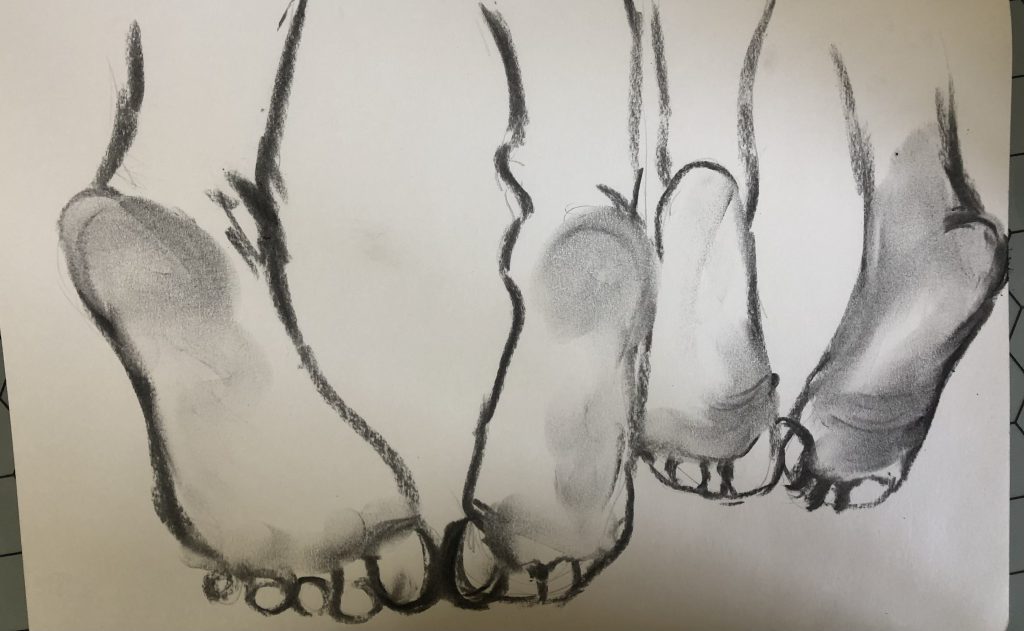
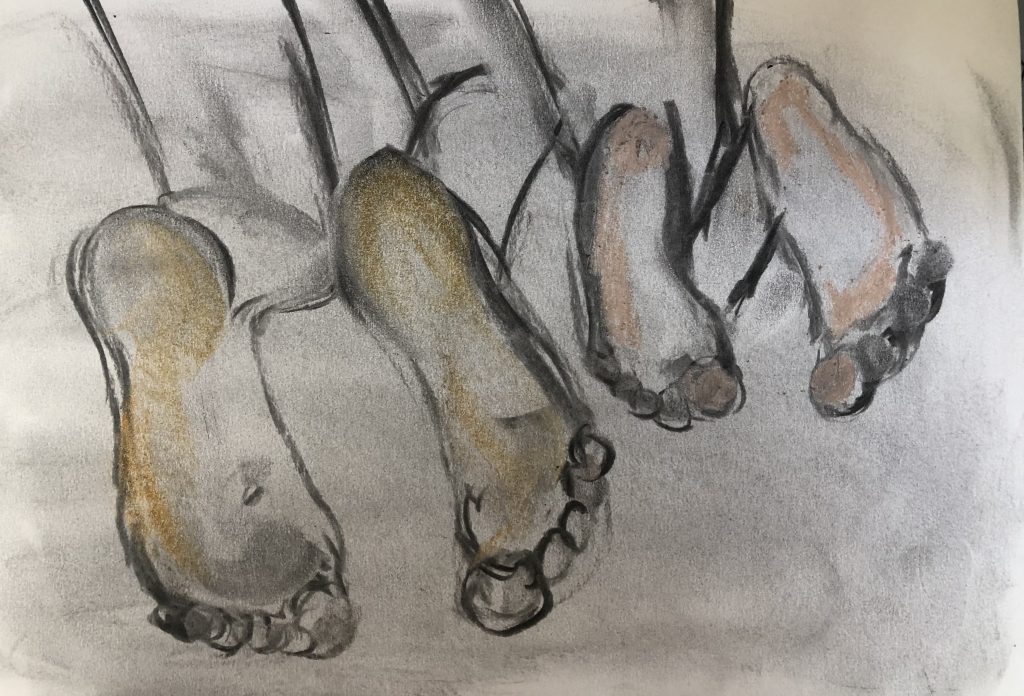
Making a work
I set up an MDF board but realized I had no gesso and decided to make a drawing on paper. I start with planning the ‘upscale’ version on the paper and spread some charcoal powder as ground. I do find my ground a bit too dark but I continue drawing out in charcoal lines where I want to place the feet. I work for 30 minutes on the initial layout and add the first pastel colours. My little granddaughter loves pink and her brother is a real outdoors boy, so I work with earthy colours as well as pink and yellow. After a cup of coffee and looking at the image and prelim drawings , I came back, re-visited the lines and added more colour, but also removed some of the background colour. This takes around 50 minutes. I decide to leave the drawing till later today.
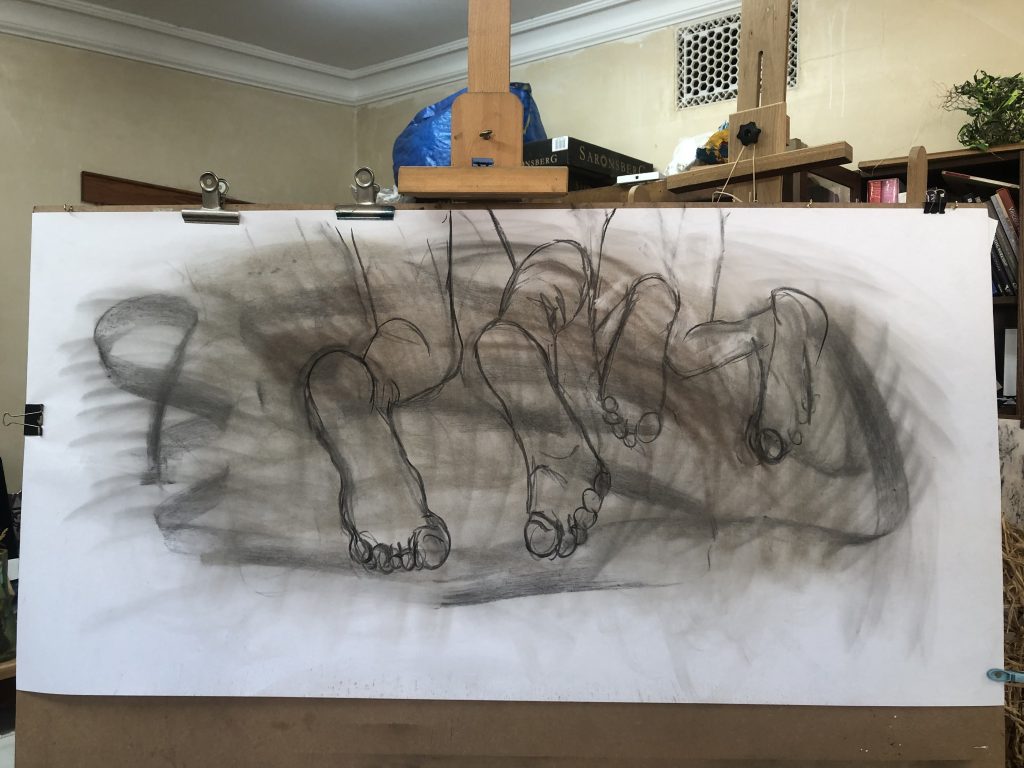
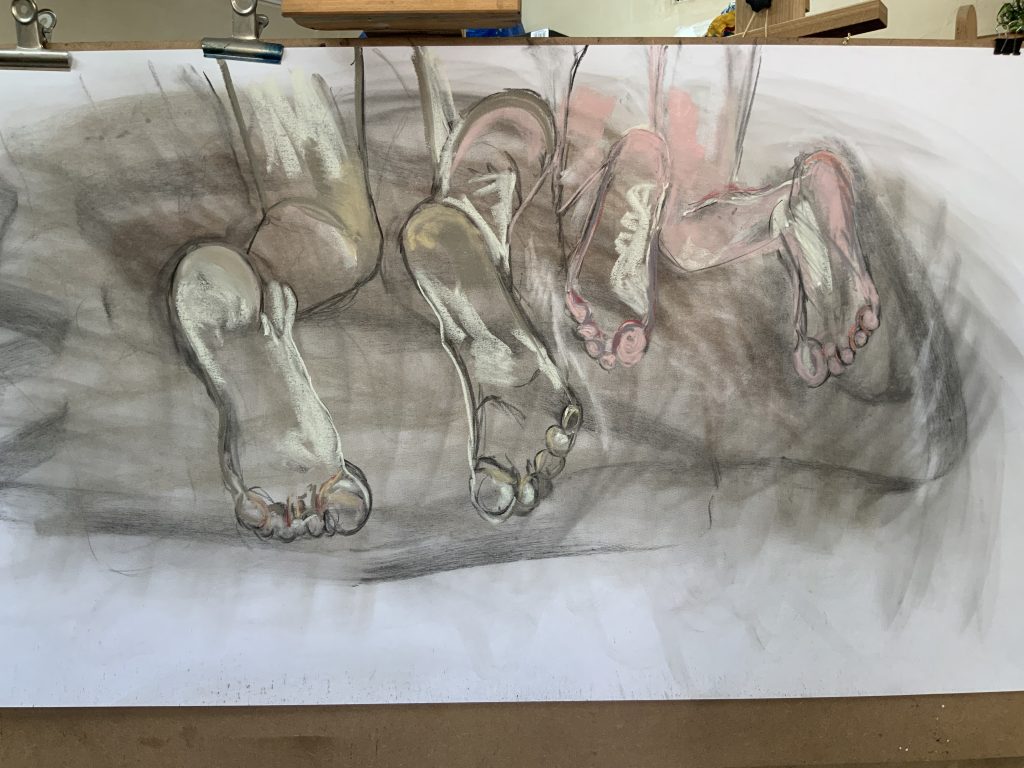
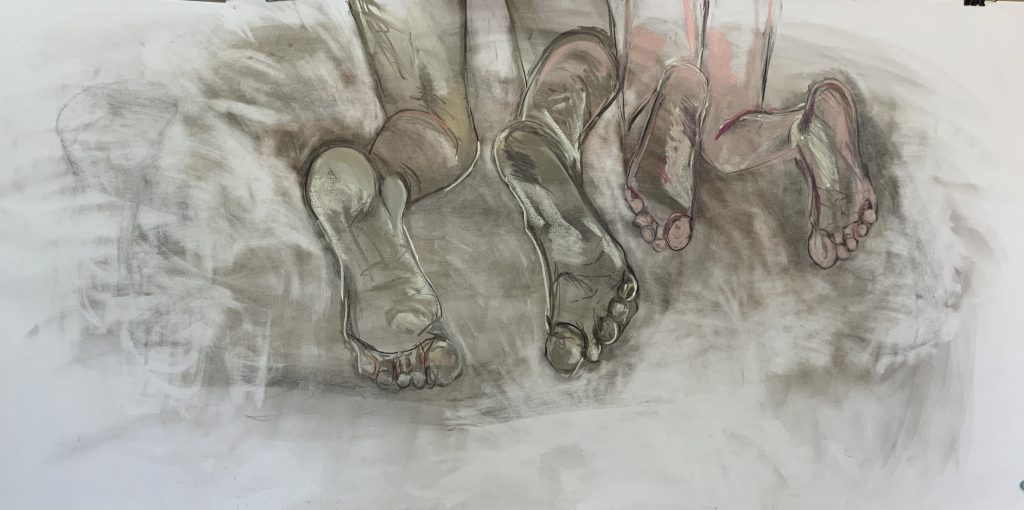
Wire work
I reshaped a small copper wire object I made earlier into a sphere shape. I photograph it and share on social media and on a WhatsApp peer crit group. I added some found bones I collected on my morning walk. I enjoy that I can experiment with form. I almost forget that the copper wire is an industrial material as the objects shares a delicateness to them. I like the idea that I can explore this interplay.
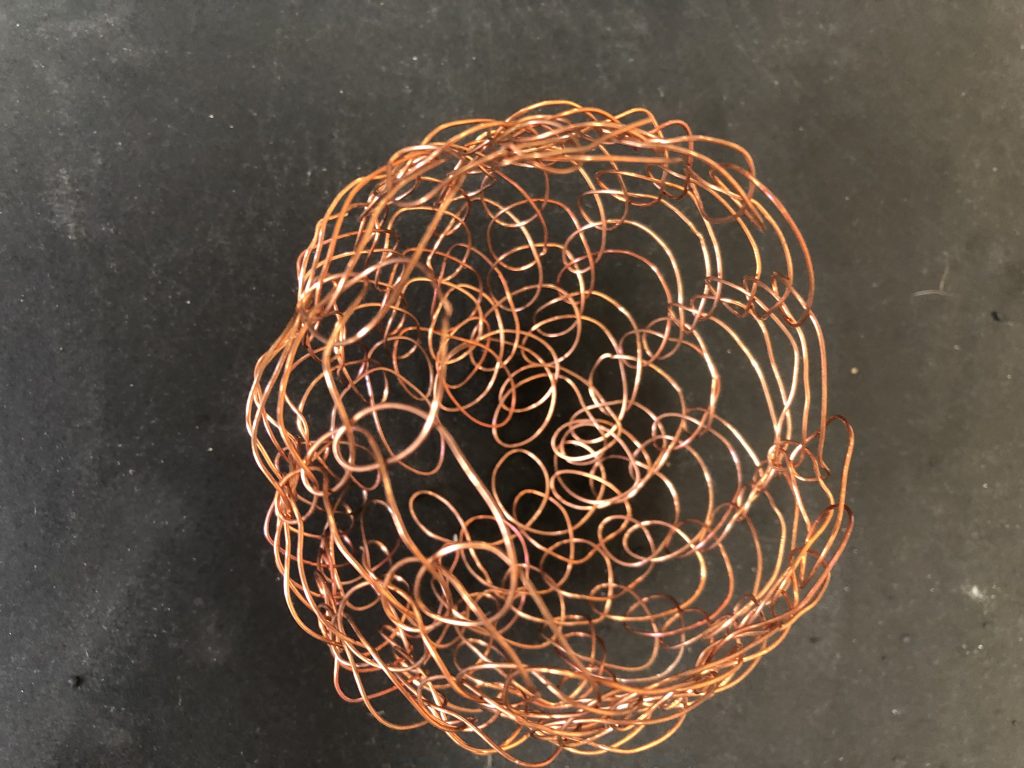
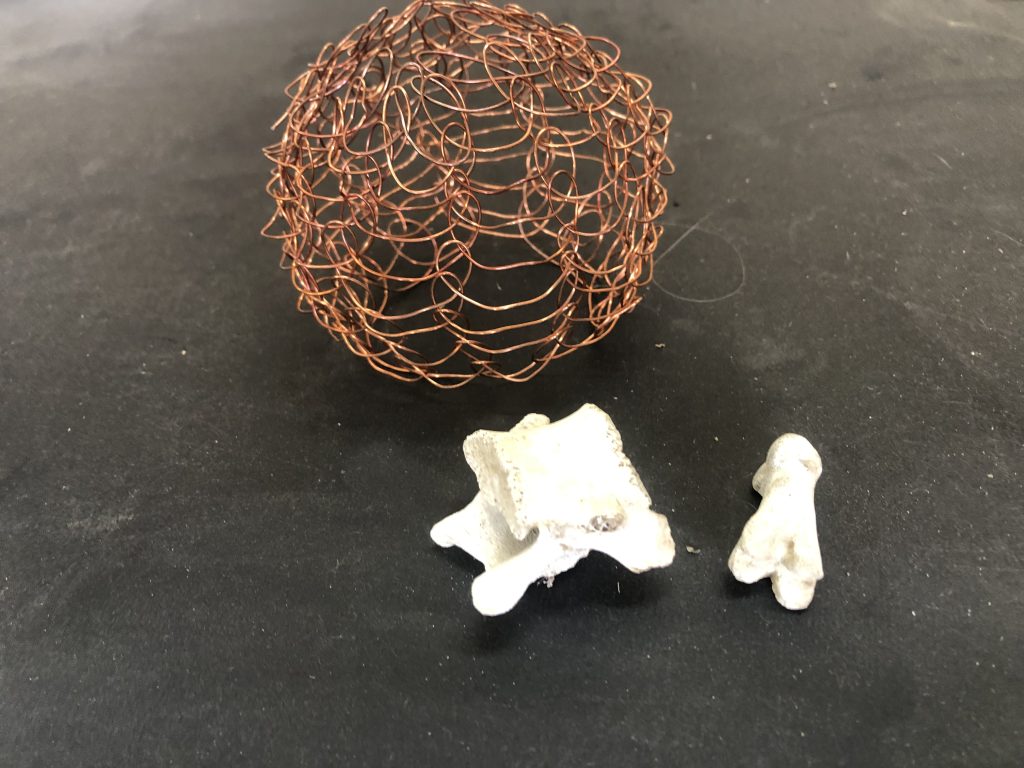
Nests
I had a conversation with a photographer who shared an image of a bird of prey on a social weaver nest. He was willing for me to use it in my work and shared more images with me. I read how these huge nests are used as ‘vantage points’ for other species to hunt or rest. Feedback from my crit group is that the interaction between other animals and the nest reminds of recycling and re using materials. I share my intentions to build a huge nests for an exhibition during August and appreciate the support to continue the plan. In the group someone share work of a South African photographer who is currently exhibiting his work in Johannesburg. He is Roger Ballen and the exhibition is called “End of the Game”. I do some research on this project and find it interesting that his work is a response to the relationship between human and animal, partly historical as he looks at the origins of the African safari and confronts viewers wither the meaning of destruction of nature, which has so much to do with power.
I spend time on sketches of nests and how I can make 3d forms.
Working on skills
I am inspired by a workshop (online) shared, which focuses on different cyanotype processes. My focus is to learn more about the wet cyanotype process. Here I want to work with various kitchen chemicals (vinegar, lemon juice, washing soda), salt, spices and natural dyes (turmeric, paprika, coffee grounds and plant material). I know that a variety of textures, colours and tones can be produced after looking at the work of Jo Stephen whom I found on a google search. I am setting out time to do more research and plan to make work. (https://jostephen.photography/cyanotype/)
Day two
As it is Saturday, this will not be a full day in the studio; we have social plans that interfere with studio work today.
Daily Drawing
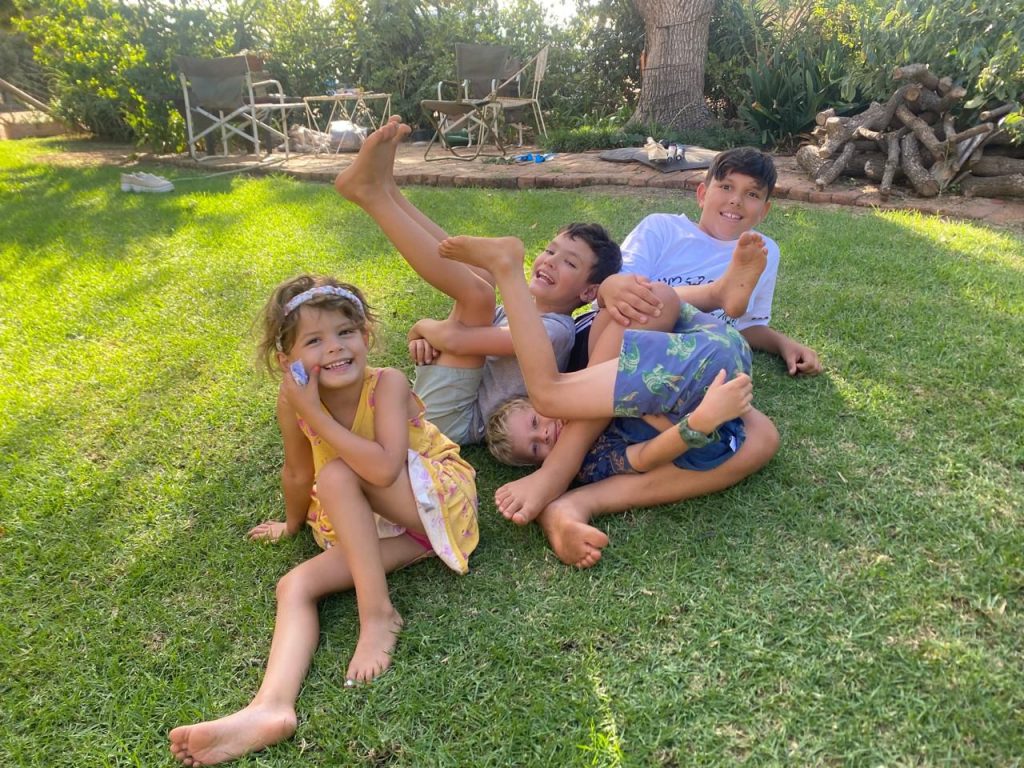
I drew a sketch inspired by a playful photo image of my grandchildren. I want to explore this as a painting, using techniques of layering and erasure. I want to capture the playful and expressive bodies as the kids play and tumble. My drawing is an abstraction as it only shows legs and feet. I quickly realised that any side should work in terms of the orientation of the drawing. The explorative sketch below is a view different from the photo reference I am using.
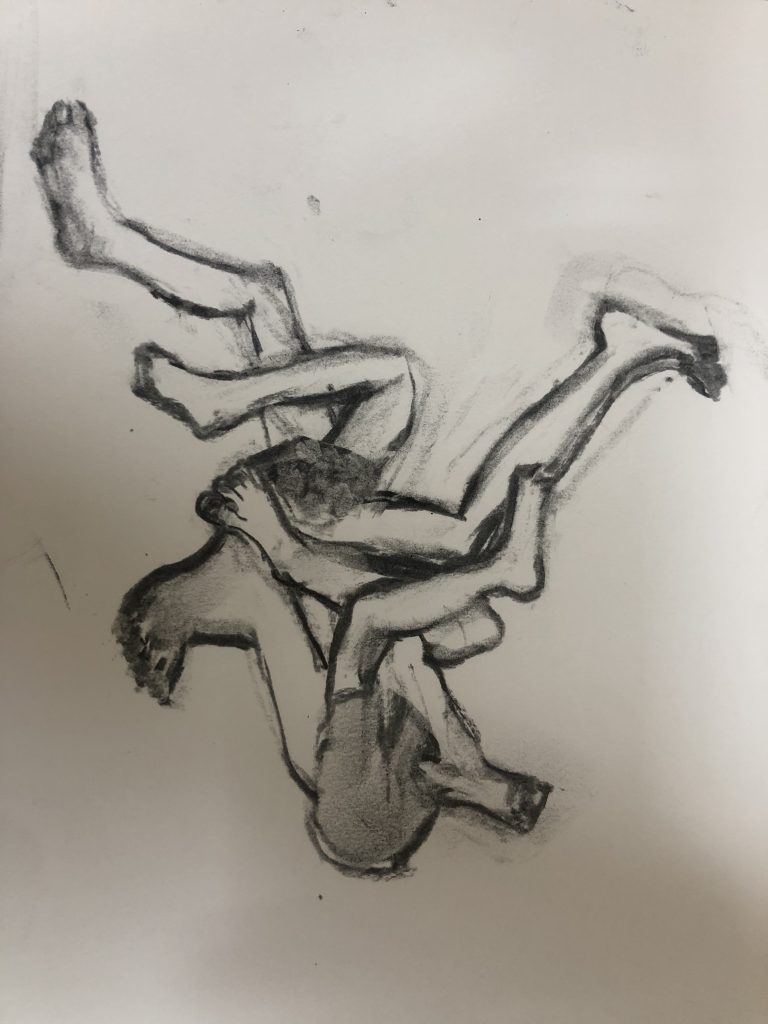
Making a painting
I want to explore layering and erasure and use a work I made earlier during the course ( Level 2) as my ground. The size is 46 x 60.5cm. My tutor and I discussed shredding or deconstructing my work in our first tutorial. I like to explore how meaning might shift if I cut or cover the surface of my work. What will happen that is new, inspire or challenge me. The surface of the work has colours and different forms – I kind of ‘liked’ the composition, but have no problem to de or reconstruct it. I feel excited of new ideas that could come to the front and almost working with the unknown.
My idea is to make the drawing onto the work and then paint the negative space. This exploration of painting was inspired by the work of a Dutch artist, Claudia Stapel, whom I follow on social media. She works mainly figuratively as she explores painterly processes. Her work is primarily monotone and layered with different removing and adding media techniques.
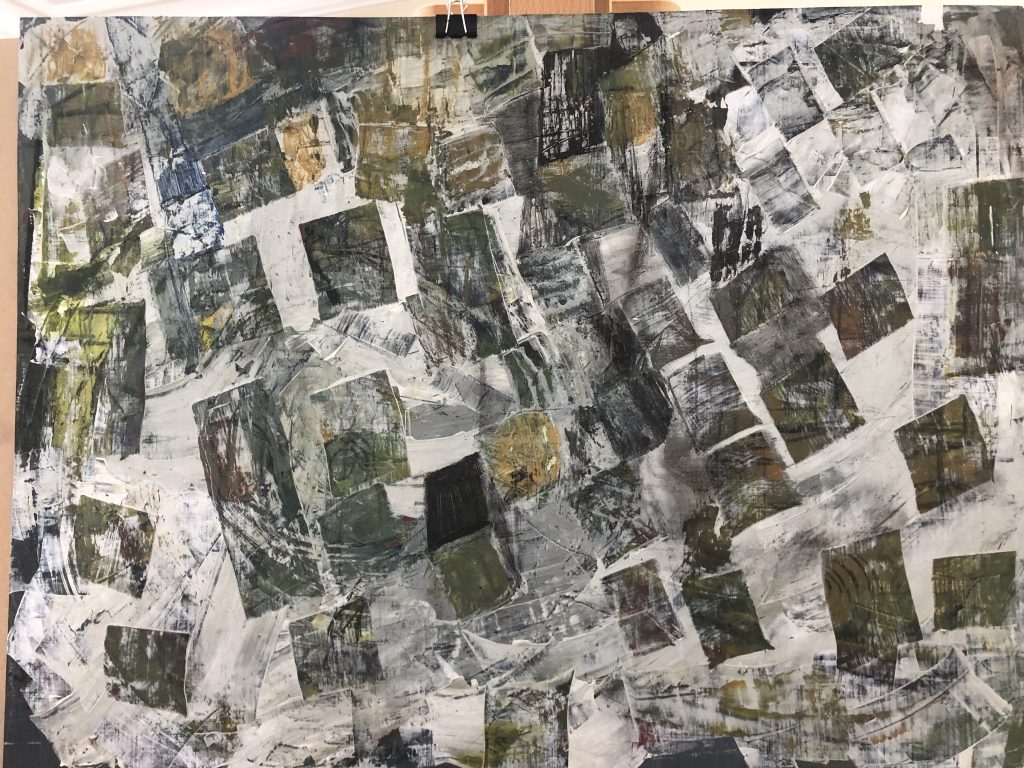
As soon as I started to work, I realised that the task at hand was not so easy: when I applied paint, I immediately had it wrong – I soon learned that it is easy to erase as I work with acrylic paint; I can scratch off or wipe off where I make mistakes. I started painting with white around the shapes I drew with charcoal. By now, I have learned that the work’s composition could work in many ways. I shared it with my WA crit group (EU student group), and comments like it is full of life or made the viewer stop to experience ‘wonder‘ were good to hear. One suggestion was to look at the flag of the Isle of Man: the three legs are based on an ancient symbol used by the Myceneaens and the Lycians, and it represents movement! (my drawing shares my four grandchildren – it is four-legged)
A little research highlighted that The triskelion (from the Greek “three-legged”) is one of the oldest symbols known to mankind. The earliest representations of it were found in prehistoric rock carvings in northern Italy. It also appears on Greek vases and coins from the 6th and 8th centuries BC and was revered by Norse and Sicilian peoples. The Sicilian version has a representation of Medusa’s head in the centre. The Manx people believe that the triskelion came from Scandinavia. According to Norse mythology, the triskelion symbolised the sun’s movement through the heavens.’ I added this little research as it made me think the work can be clockwise or anti-clockwise. I was also reminded of the work of Jasper Johns in the 1950s and the flags he painted – using encaustic techniques to create a textured surface. My painting is also layered with paint to create a layered and textured surface. It reminds me of my big dream to make sculptures or 3d objects. I already ‘see’ a little clay sculpture to sit next to the work.
Below is some documentation of my making process, which followed over the next hours. I work with acrylic paint. I like the freedom of expressing and exploring whilst making this work. I am contemplating why I make this work and must be content with the idea that this is my current state of mind. What am I exploring or learning? Why the figurative? I think it has to do with sculptural thoughts and the potential of the body form. I like the idea of taking things apart and then putting them back together anew.
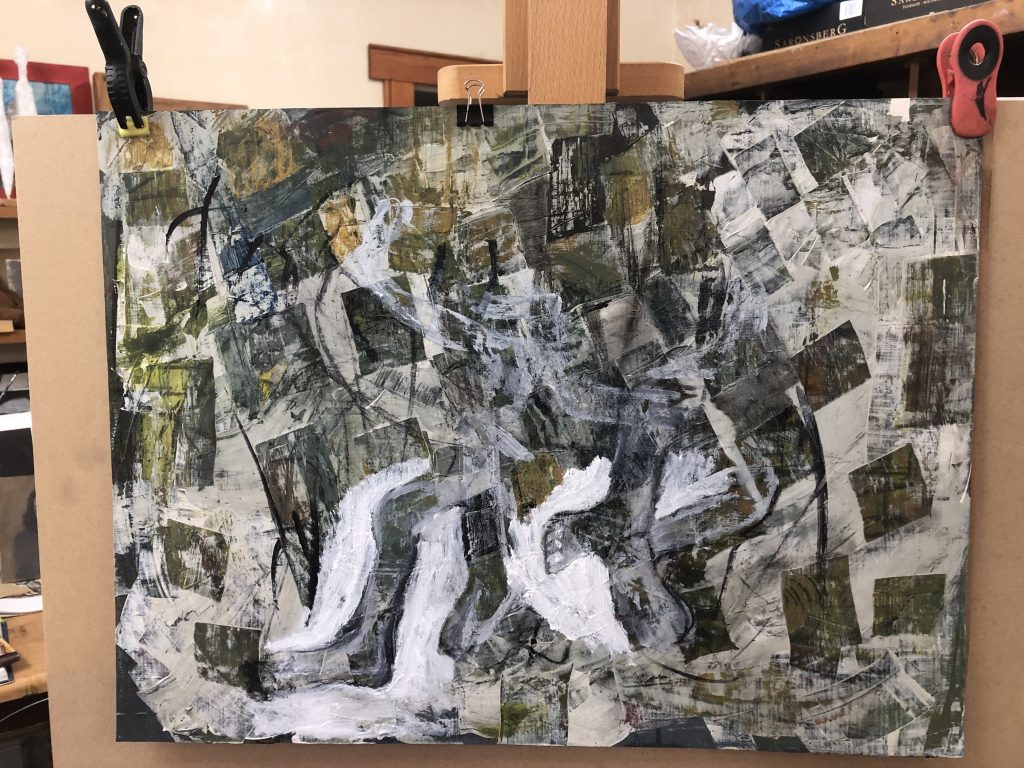
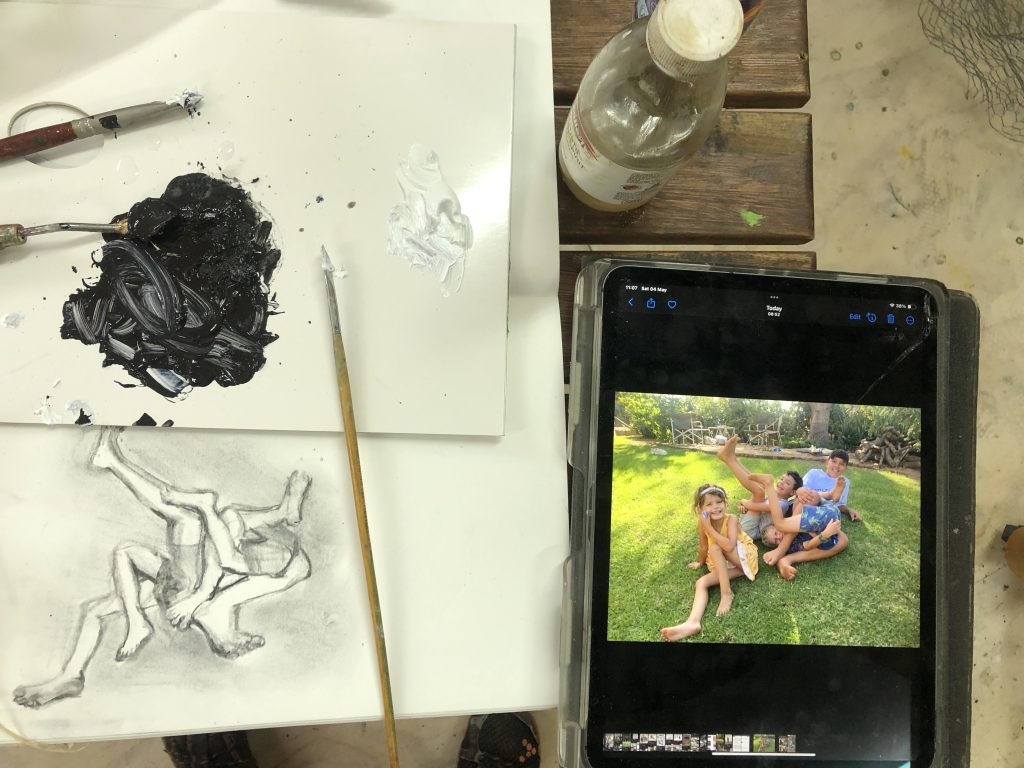
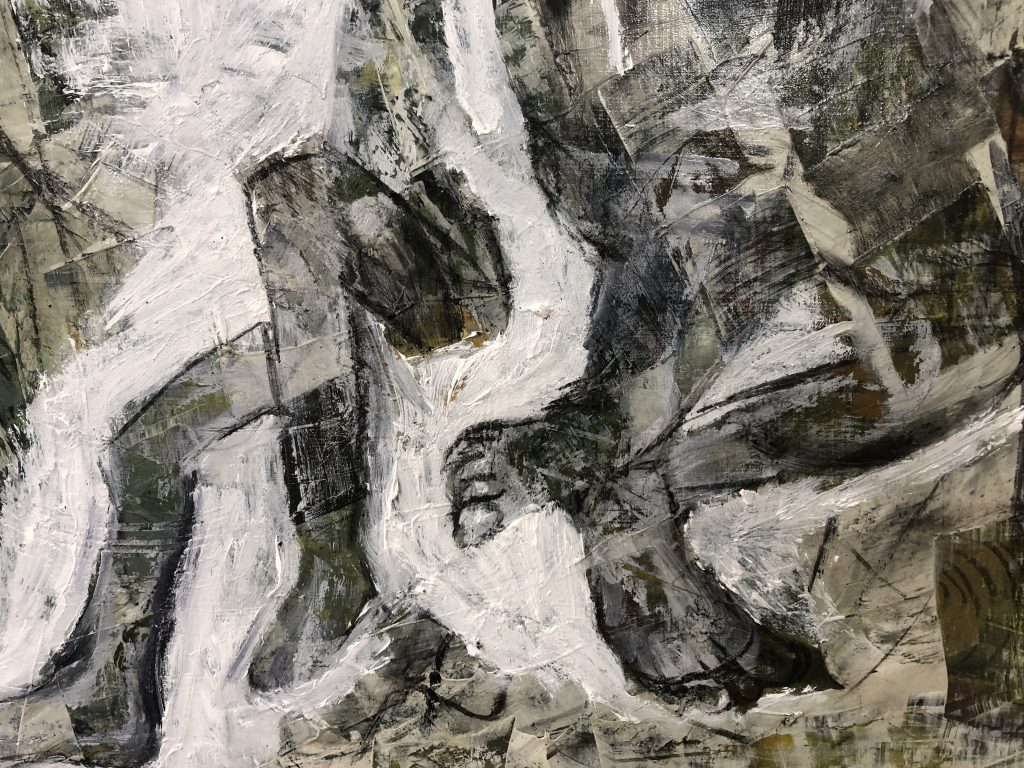
WIP shared in different orientations:
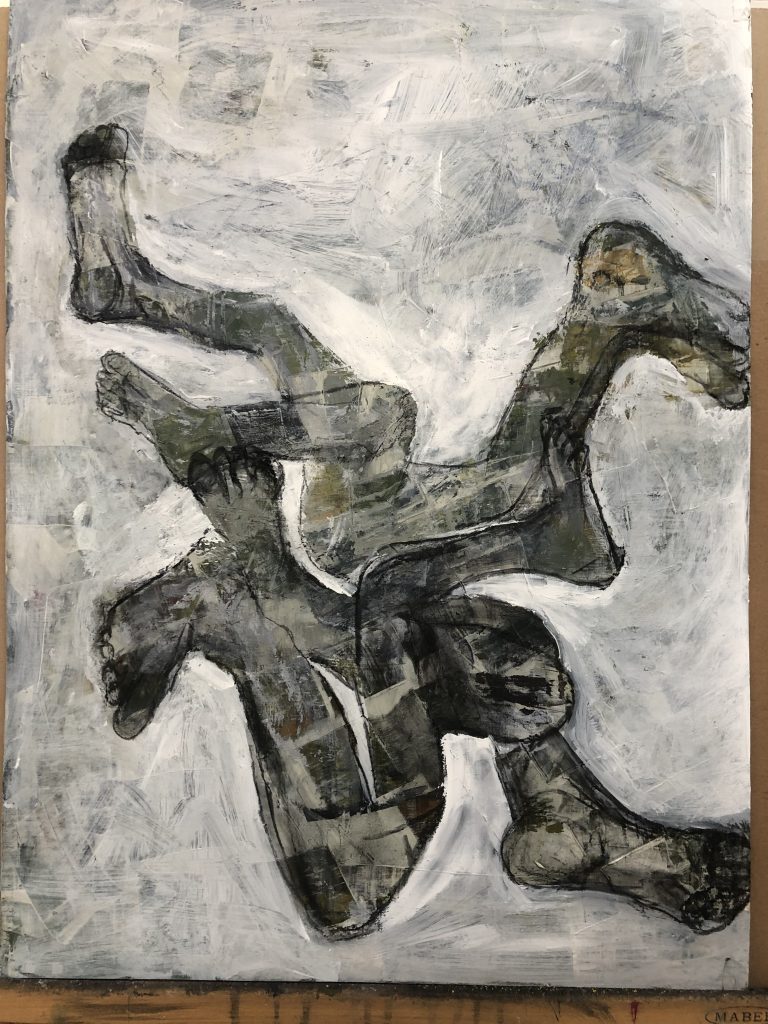
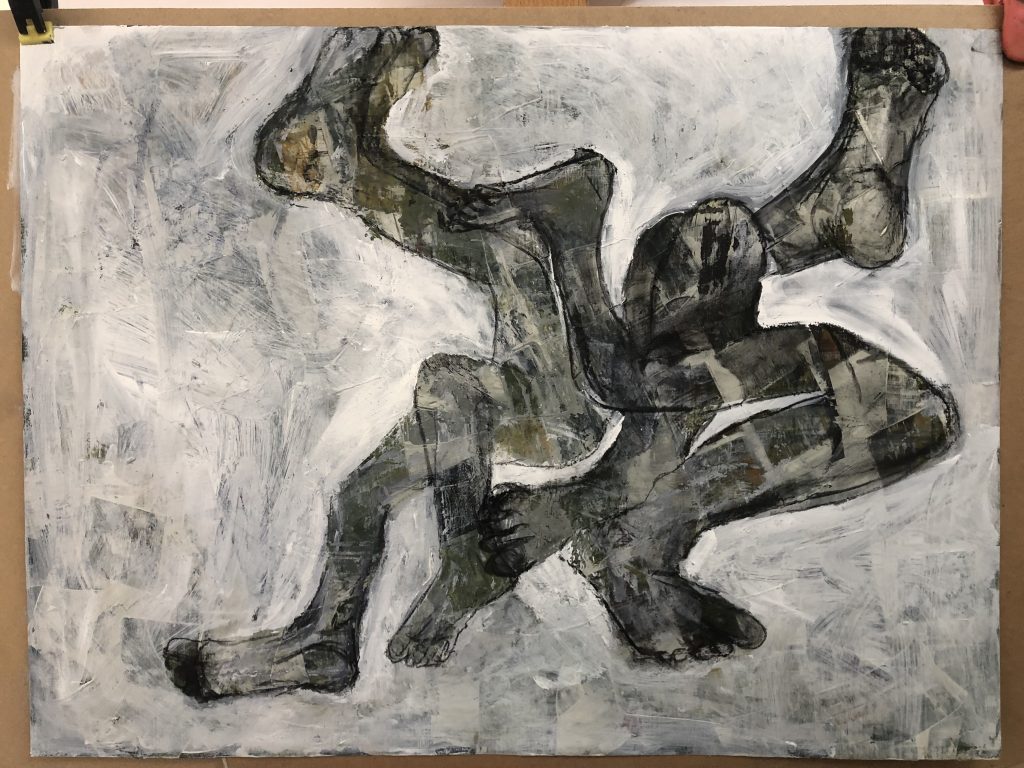

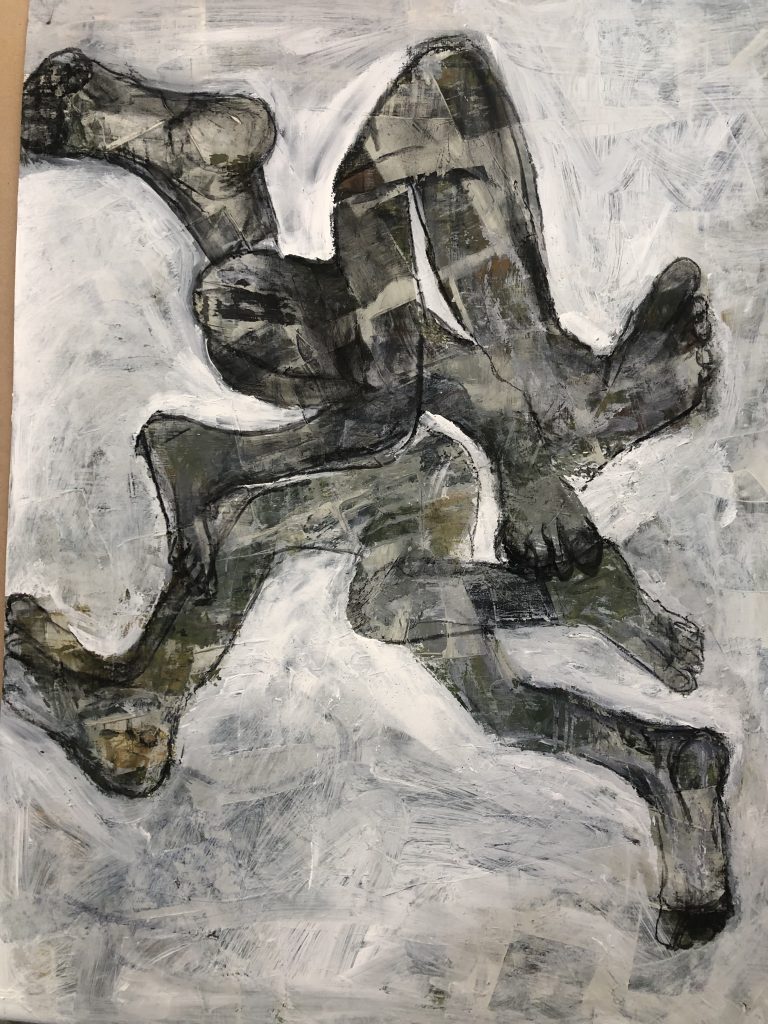
At this point, I leave the work to stand for a while – I am unsure if I should cover the background (negative space)with more painterly white strokes. I need to work on the shapes I created, as I can still improve by scratching out the white paint or blocking areas with paint or gold leaf/gold paint. I have gathered some gold leaf and contemplated using it. I have never worked with it before. I can also do more ‘drawing’ of the shapes – the feet need more refining, and I will explore this. Do I have to consider other drawing materials – wax crayons, pencils? I am aware of my attraction to the work of Anselm Kiefer and Cy Twombly and wonder if I need to view their work and methods before I continue with the painting. The work of Kiefer below, is curated by Arturo Galansino. The following was taken for the website:”…. the exhibition aims to restore the complexity of Kiefer’s artistic universe, highlighting the profound intersection between figurativity and abstraction, between nature and artifice, as well as between creation and destruction. This project involves viewers in a dimension that embraces both the physical space and the conceptual world of the artist’s works.”
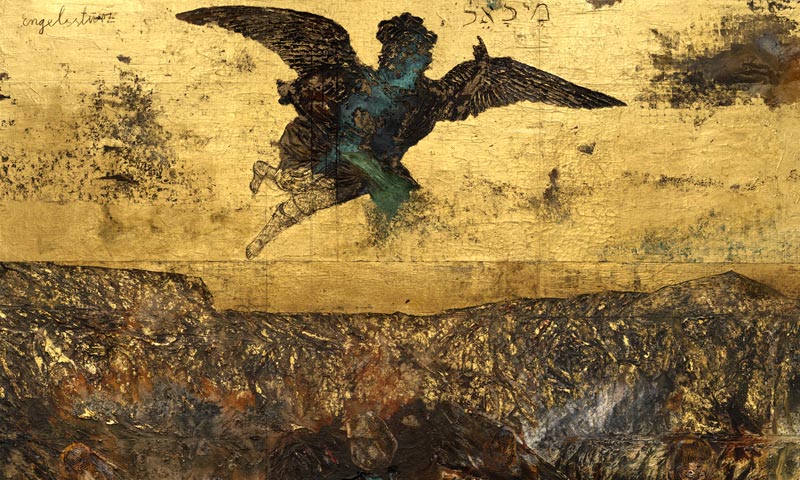
I enjoy the energy in Cy Twombly’s work. In the work below, I can see that he has used techniques of layering and scratching the surface. By exploring, I believe I can develop my repertoire of marks and methods, and I am complicit in that I need to consider what I want to convey to a viewer by those marks. I can discuss this with a critique/peer group.
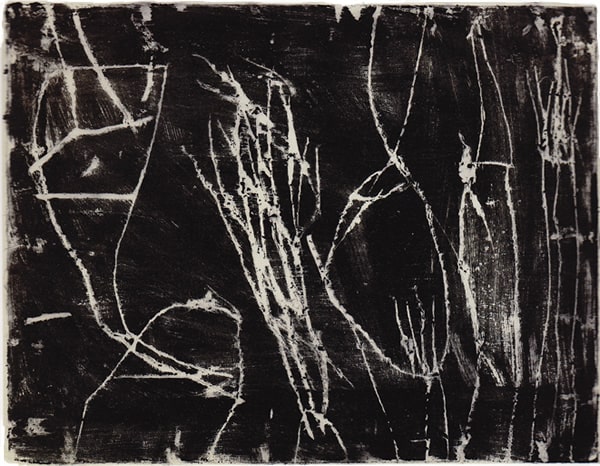
Day three
Daily Drawing
This is a three-minute drawing—using erasure but focusing on the drawing I started on day 1. I explored/experimented with the ground of this small drawing (12 x 10 cm) in my sketchbook by using charcoal and making looping scribbles on it. I then made the drawing with an erasure by focusing on a more structured way of exploring making. I like the idea of repeating the same image – I see new potential in the work I can explore. I see this as a successful exploration of almost excavating an idea.
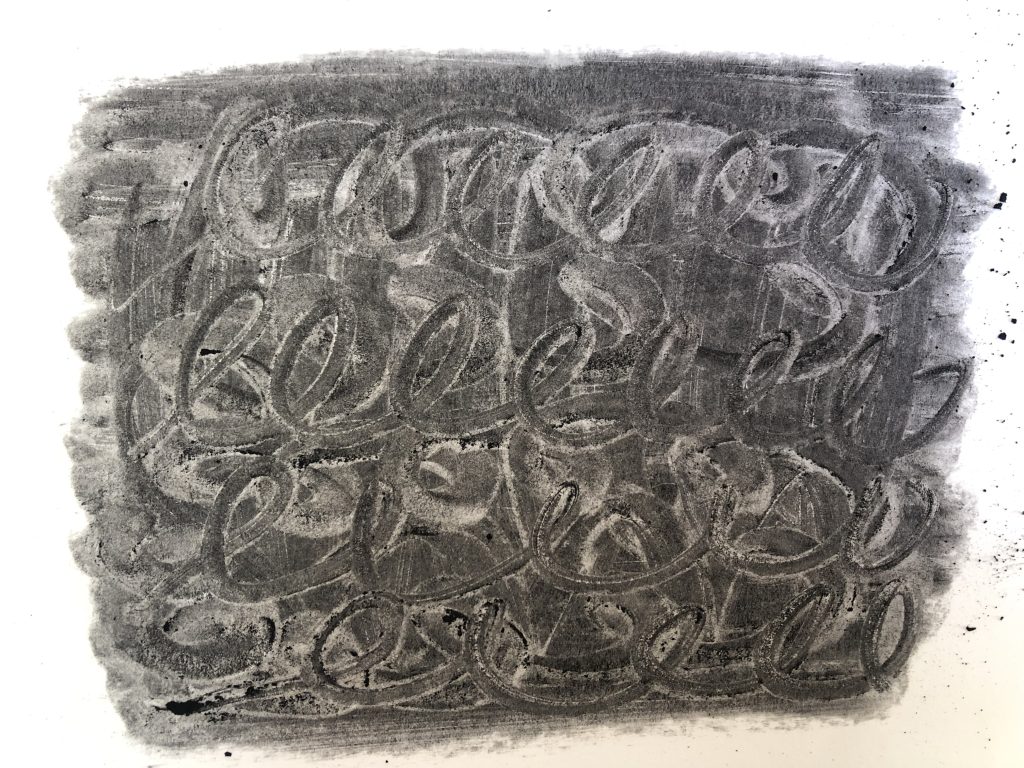
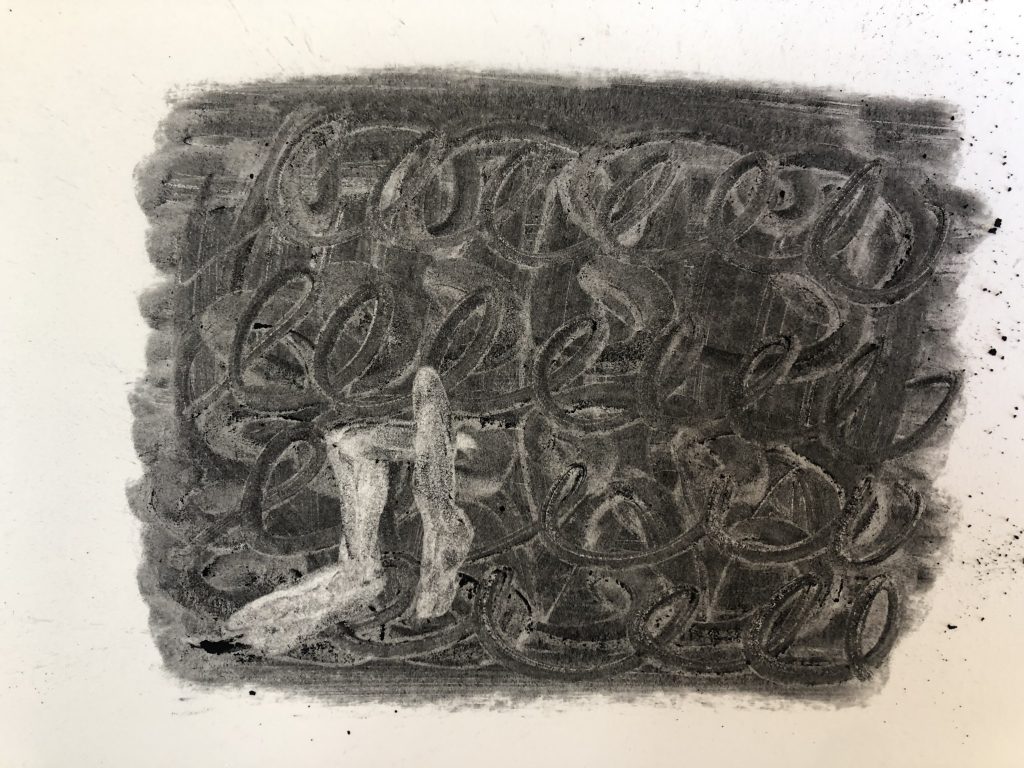
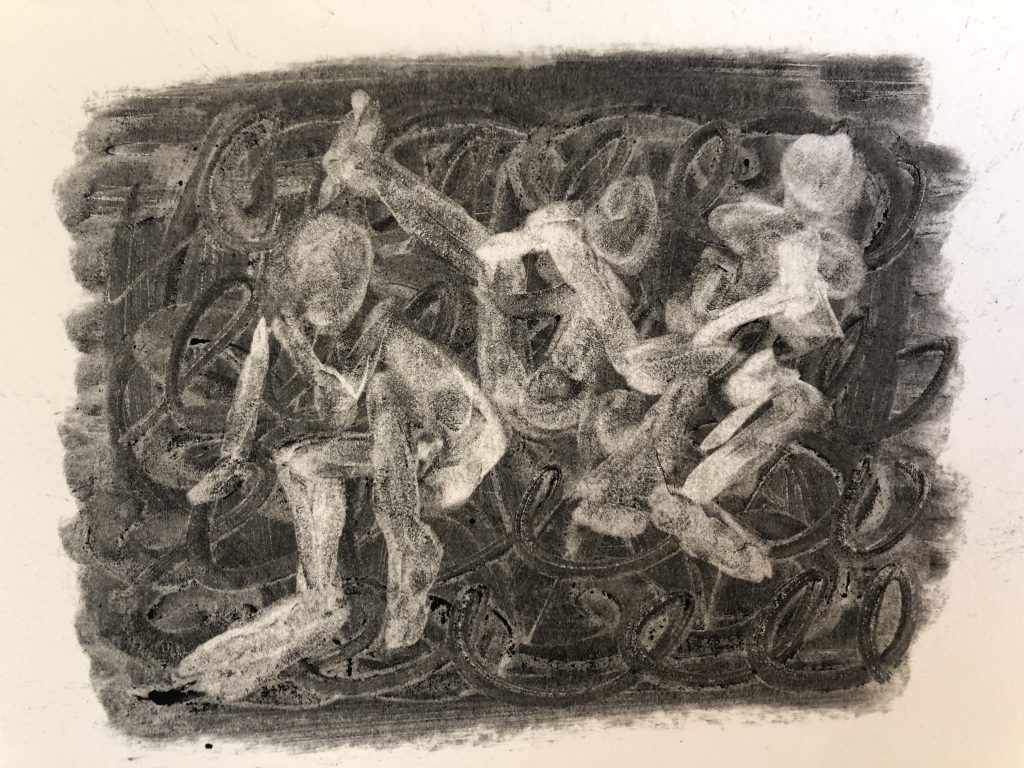
Admin
I write notes in this blog and review the course material. I started planning the self-reflection for the first exercise and reviewed the rest in Part Two. I want to start with exercise 2 during the day and do the drawing, which takes around one hour. (see below in Exercise 2)
A Zoom meeting will consume a big part of my morning. I work with an NGO exploring visual art with young children, and we are planning a local exhibition.
Day four
Daily Drawing
I added gold acrylic paint to the ‘8-foot’ mixed media work. The question to myself is, do I do the gold layer ‘thicker’ and
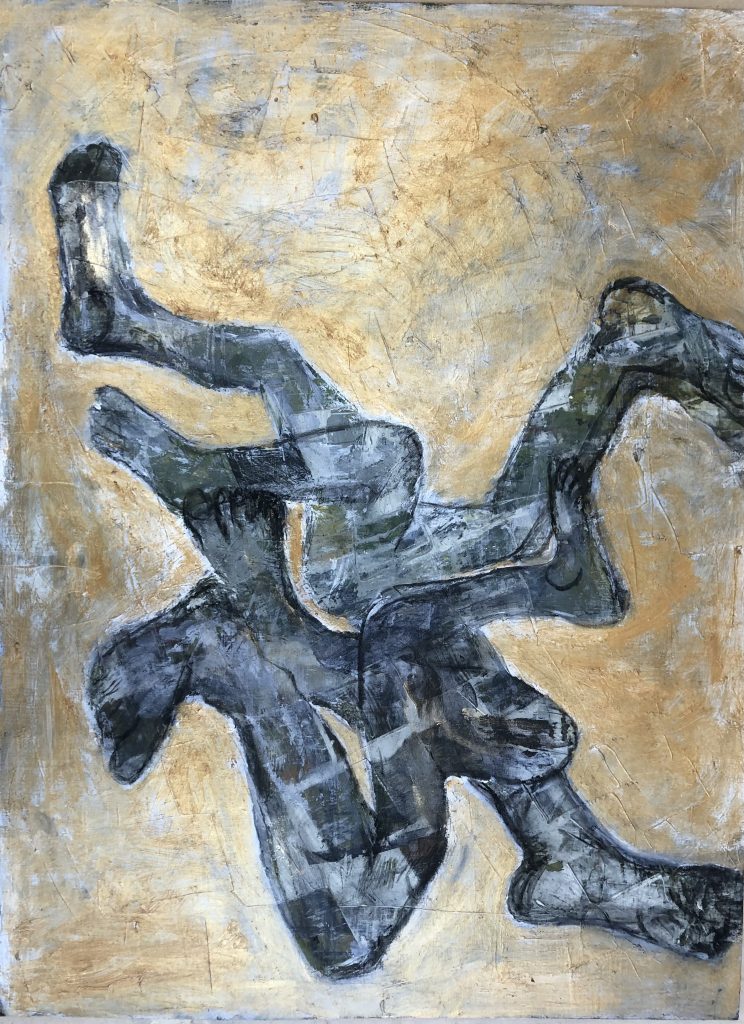
I did the last work on the drawing for the next exercise in the course and wrote comments on the experience in my blog. I spent time listening to a reading by Terry Tempest William and downloaded the e-book When Women Were Birds. I have a line to keep: “What is birdsong but ‘truth in rehearsal’?
I am back to thinking about Barad’s diffractive practice, which I contemplated earlier in my studies. My practice is an engagement that emphasizes material objects and experiences. I am looking for relations (kinships) and use my explorative making in the studio as the place where these intra-actions happen. The work becomes messier and even more uncertain. How do I now find points of departure and relationships with viewers and my peers? Has it become messier? Does the work stay works in progress? Have I built a body of work? Text becomes necessary – or is this just because I use a blog for my student work as I search for meaningful making? Compared to archival ideas, I take time to consider the role of impermanence (ephemerality) in my work. The work with nests has opened me up to this. I have two nests hanging outside on the veranda, facing North/East direction since October 2023. Here, the work of land artists comes into play, as well as documenting over time.
On social media, a photographer friend shared a video of a dramatic scene happening in and around a sociable weavers’ nest. The video shows how the birds’ interdependence with the small pigmy falcons plays out when a snake attempts to attack the huge nest. I have never seen such an attack in the wild, the video is dramatic to the end—when the snake decides to move on.
want to do some research on artist, Lara Pr
Day five
Day six
Day seven
EXERCISE 2 That Bright Grey Eye by Hilda Morely
The grey sky, lighter & darker
greys,
lights between & delicate
lavenders also
blue-greys in smaller strokes,
& swashes
of mauve-grey on the Hudson—
openings
of light to the blue oblong
off-center
where the door to the warehouse
shows—
the larger smearings darkening
deep
into blues
So alight that sky,
late August,
early evening,
I had to
gasp at it,
stand there hardly moving
to breathe it, using
whatever my body gave me,
at
that moment attending to it,
thinking:
Turner, he should have
seen it,
he would have given it
back to us,
not let it die away
And that other
evening, walking down Bank Street from marketing,
the sky fiery over the river,
luminous but
hot in its flowering also,
rich in color
as Venice seen by Guardi—more aflame even,
the sky moving in a pulse,
its fire breathing
in a pulse verging on danger—mane of a lioness
affronted.
That brilliance—the eye of the lion
filled to the lids with
flame
And his eyes, Turner’s, that bright grey eye
at seventy-six,
“brilliant as
the eye of a child”
who grew his thumbnail
in the shape of an eagle’s claw,
the better
to use it in painting
In Kirby Lonsdale, Yorkshire,
where Turner first drew mountain-landscapes,
I found Blake’s Marriage
of Heaven and Hell—sold for two guineas, 1821
& Turner aged 46 that year
& there I read:
“And when thou seest
an Eagle, thou seest a portion of genius.
Lift up
thy head,” says Blake.
These afternoons now,
late in September, 76,
the sky, the river are lit up
at the end of Bank Street, at Bethune.
The pavement
trembles with light pouring
upon it
We are held in it.
We smile.
I hold my breath to see if
the cashier in the supermarket
will be gentle with the old lady who cannot
read the price-tag on
a loaf of bread.
Then I breathe freely,
for yes, she is helpful, yes, she is
kind.
Outside on
the pavement, the light pouring itself away
is the light in the eagle’s
eye (or the eye of
a child)
(I saw it in a man’s eye once:
but he’s dead now more than
four years)
Drawing heat out of
surfaces,
the light is
without calculation,
is a munificence now,
is justified.
new york, 1977
Hilda Morley, “That Bright Grey Eye ” from To Hold in My Hand: Selected Poems, 1955-1983. Copyright © 1983 by Hilda Morley. Reprinted with permission from The Sheep Meadow Press.
Source: To Hold in My Hand: Selected Poems, 1955-1983 (The Sheep Meadow Press, 1983)
I am inspired by the fact that she is also a student from Black Mountain College, where Ruth Asawa studied, and I love her interest in the natural world. She describes this interaction as so beautiful. My idea is to draw a solitary figure, standing still and gazing up at the magnificent sky, as described in the lines “stand there hardly moving to breathe it.” The figure could be portrayed in a contemplative pose, their body language conveying a sense of awe and wonderment. I want the expressions on the figure’s face to suggest a deep connection with the natural world around them. I want to look at J.M.W. Turner: As mentioned in the passage, Turner is renowned for his mastery of light and atmosphere in his landscape paintings. His late works, in particular, often convey a sense of awe and transcendence in their portrayal of the natural world. I also consider more contemporary work. Olafur Eliasson, known for his immersive installations and large-scale artworks, comes to mind as he incorporates elements of nature and natural phenomena into his pieces. His works play with light, colour, and perception, creating experiences that evoke a sense of wonder and awe.
I work with pastels in my sketchbook. As soon as I start the sketch, I am reminded of my work during the COVID-19 pandemic – the sense of loneliness and the beauty of the open skies. (we were here on Langvlei farm for 7 months, and it was the time we made the final decision to come back to South Africa after having been in the UAE (Dubai) for 4 years) I only work with orange, yellow, and light blue pastels, and I am moving towards the brightness and warmth of being in the sun and outside in nature. Words are also scribbled down. I enjoyed where the exercise took me and soon learned I could erase with ease. This is why I like working with charcoals and pastels – one can easily rub into the work and change or remove lines or marks.
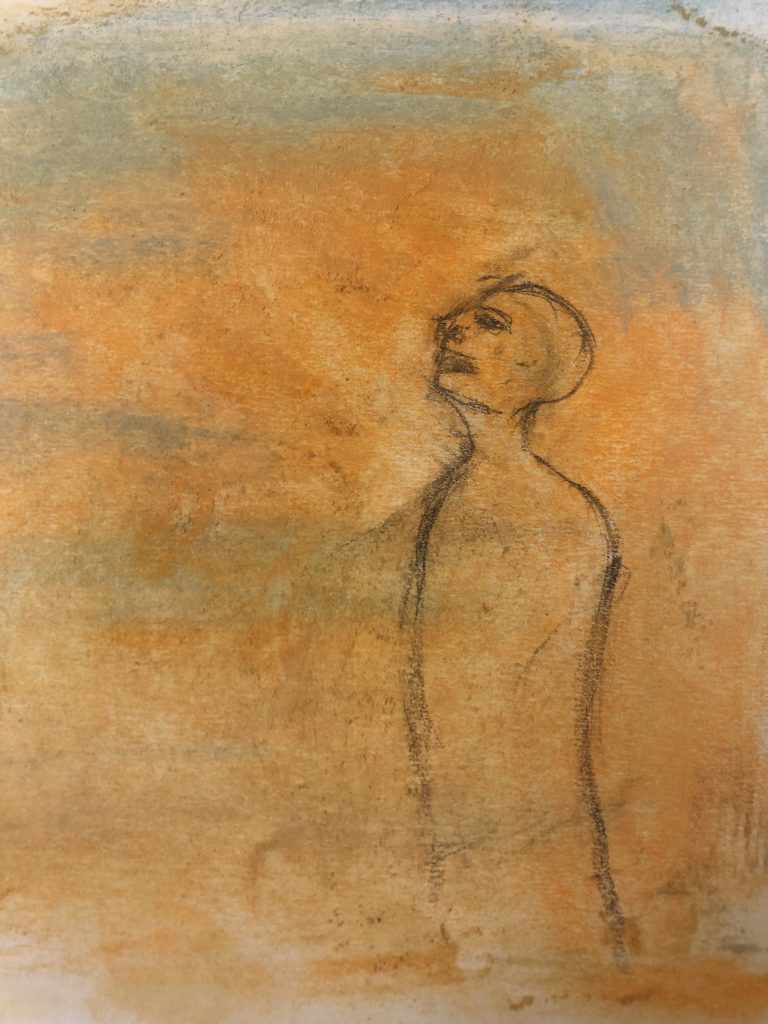
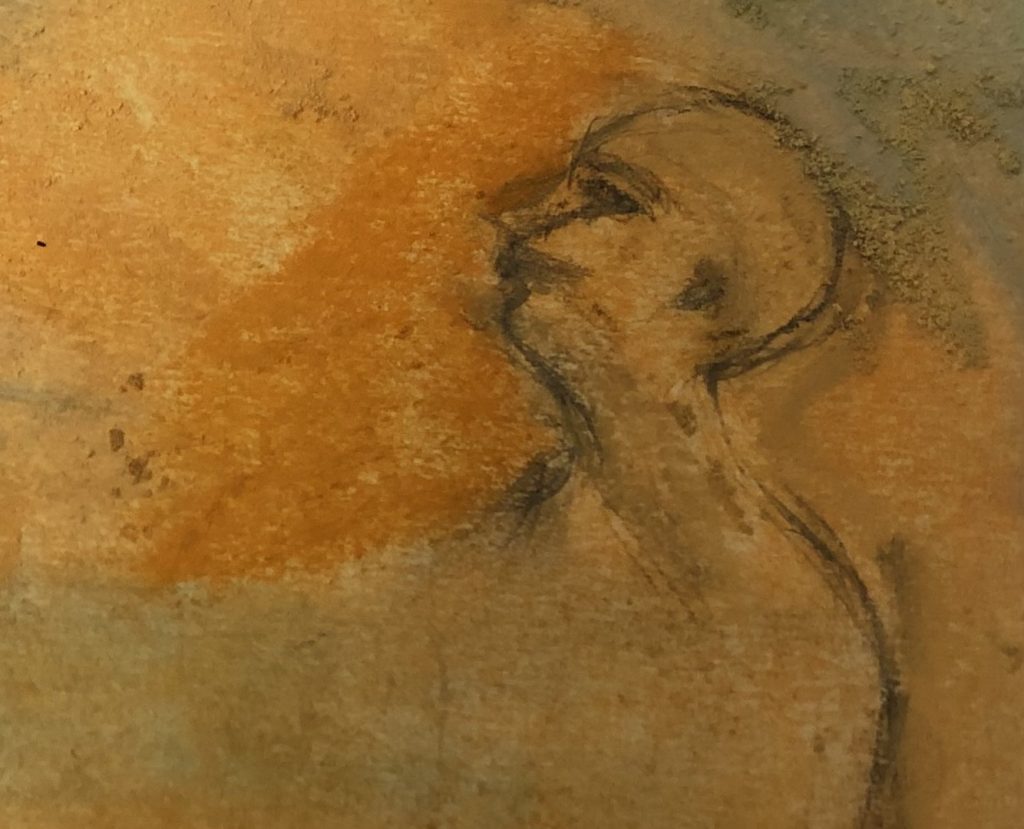
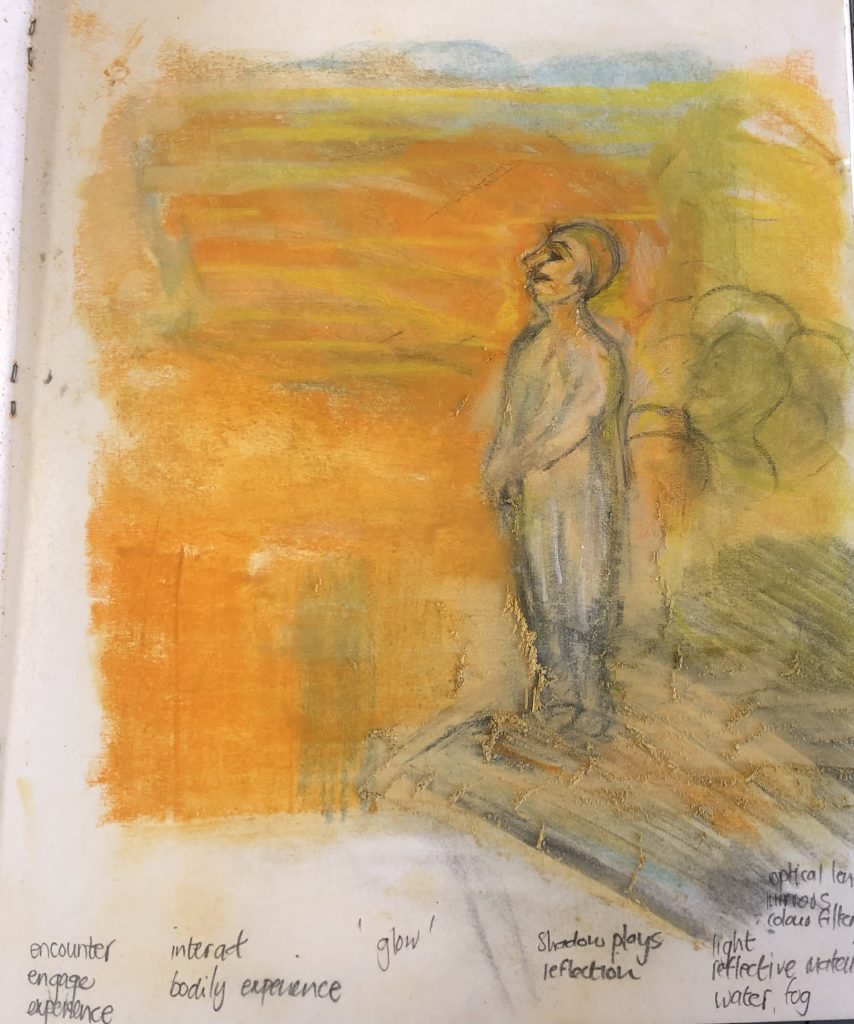
I am not happy with the outcome, but there is a particular atmosphere and bodily experience. Still, I liked the idea of working with landscape and contemplating and imagining an encounter/moment of beauty, which I would primarily relate to and experience of being outside. I am reminded of a recent photo of my husband and me at the beach as the sun was shining low, just before sunset. The main focus was the experience of seeing the sky and being mesmerised by the colours. It reminds me of the connectivity one feels when sharing something special. My reading took me to the work of Terry Tempest Williams, who wrote the book When Women Were Birds. Both these writers have contemplated ideas of womanhood in their time – having a voice as a woman. I sit with ideas of why I enjoy working with erasure – words of Tempest Williams, “rub or scrape out, eliminate, remove, rub out, obliterate, delete, exile, blank, cut, blot, dispatch, tripe, wipe out,withdraw …black out, block out.. resonates. I add a video of a reading to my blog. I am glad I could contemplate an engagement with these ideas – all talking to me about trying to make/paint/draw what I see, hear, experience…which is sometimes about silence.